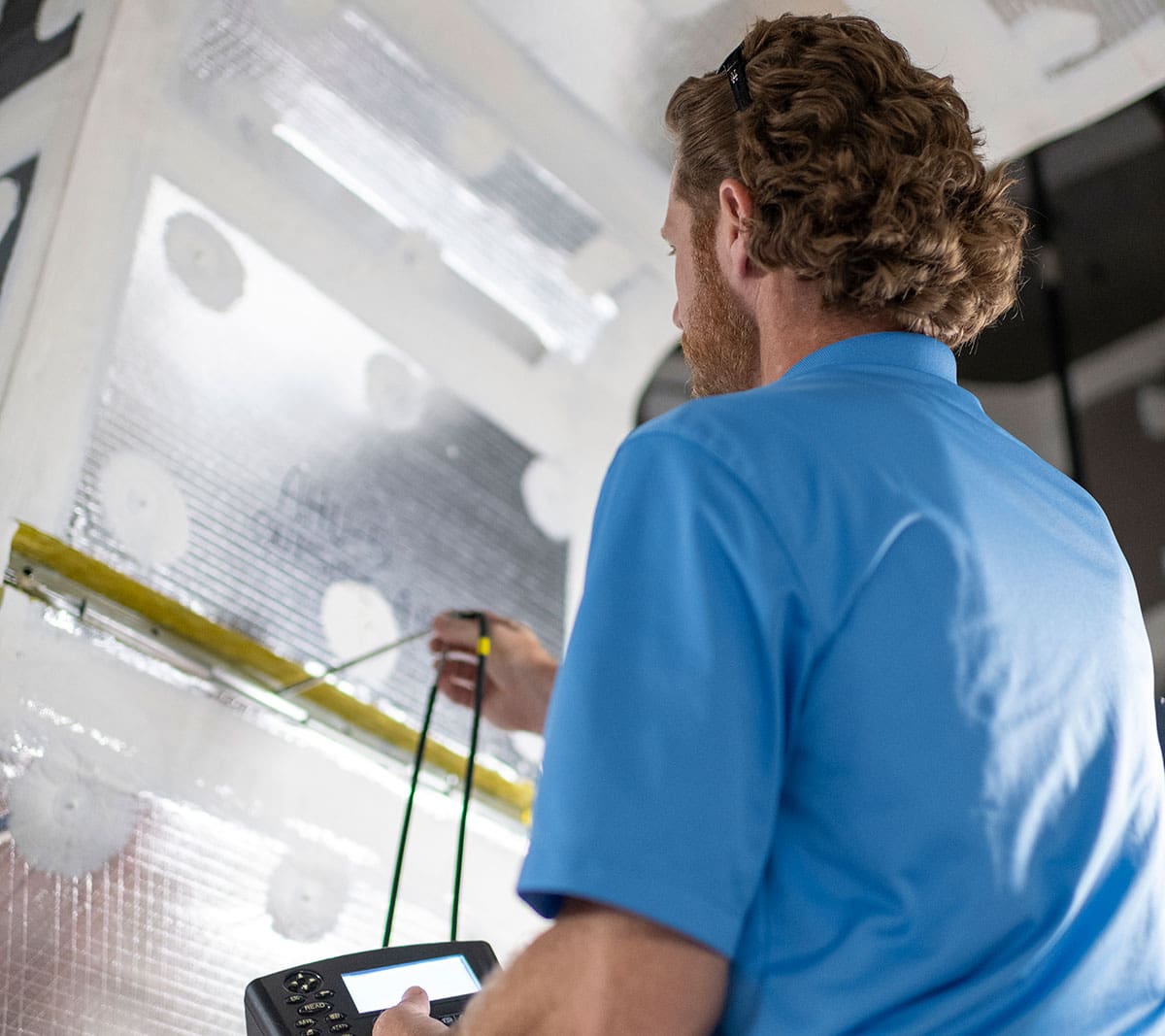
October 25, 2022
The measurement of outside air being introduced into a building is of major importance for maintaining correct indoor air quality and to assist in maintaining positive building pressure when required.
In the testing, adjusting, and balancing industry, direct and actual measurement of outside air is the most recommended and recognized method used to determine outside air volumes. There are two methods of actual measurement and one method for determination by temperature method. The following are the methods recommended by NEBB in order of their accuracy.
METHOD 1
This method is a direct duct velocity measurement known as a duct traverse test which is performed using a Pitot tube and a velocity reading instrument (Figure 2-3, Figure 2-4, Figure 2-5). The most accurate reading is obtained at the outside air duct – given that air flow is uniform – six to ten diameters of straight duct upstream from the test location. Velocity test readings can also be obtained under the equal area or Tchebycheff method for rectangular and round ducts (refer to Pages 10.15 and 10.17, NEBB, Procedural Standards for Testing, Adjusting, and Balancing of Environmental Systems, 1998 Edition). Instruments which may be utilized with the Pitot tube are:
1. Micro-manometer (analog or digital) – For very low velocities (under 500 fpm) – very accurate.
2. Inclined or Digital Manometer – For moderate duct velocities (over 500 fpm) – very accurate to moderately accurate.
3. U-Tube Manometer – For high velocities (over 1000 fpm) – moderate accuracy.
4. Magnahelic Gauge – Various ranges of gauge will improve accuracy, allowing readings of over 400 fpm.
Direct measurement of the outside air duct eliminates any question which may be raised regarding the actual amount of outside air entering a system and/or building. The readings obtained with the instrumentation are in velocity pressure (VP) or, depending on the instrument, in feet per minute. If in VP, then the readings must be converted to fpm by use of the standard equation, at sea level, at 70 ° F.
METHOD 2
This method for determining outside air volume is done by testing two ducts and then assuming the results. This method of reading the velocities is the same as described under Method 1; however, problems can arise when employing this method.
Air density (d) at standard conditions equals 0.075 lb./ft.
After converting velocity pressure to velocity (fpm), then the fpm is multiplied by the area of the inside of the ductwork to obtain air volume (CFM = area x velocity), for example:
The average velocity pressure of readings is .08 (16 readings)
Duct size is 12″ x 12″ at sea level
70°F. temperature
FPM = 4005 x .08 = 1133
CFM = A x V = (12 x 12/144) x 1133
CFM = 1133
EXAMPLE
The Mechanical Room in a building serves as a return air plenum with both a return duct and an outside air duct entering the room. The supply air and return air ducts are tested, then the calculated return air volume is subtracted from the calculated supply air volume, with the assumption being that the result is the total outside air volume. There may be, however, significant leakage from the Mechanical Room to the building or to the outside. The assumption of return air volume then is faulty. Not measuring the outside air, return air, and discharge air supply can lead thus to inaccurate results.
Open end ducts which lead to a Mechanical Room should be read utilizing a 4″ Vane Anemometer (Figures 2.8 and 2.9), which produces an indirect reading (fpm x open area Sq. Ft. = CFM) or a direct reading flow hood may be utilized (Figure 2.14).
METHOD 3
This method utilizes temperature differential which is decidedly the most inaccurate method – acceptable only when Method 1 and Method 2 are not able to be employed. First, a total of the air volume must be measured from a supply duct or multiple supply ducts must be tested by traverse as described in Method 1.
Next the temperatures of the return air, mixed air, and outside air must be obtained. Multiple temperature readings in each of the air streams – averaged together – will provide the most accurate results. Once the air volume and temperature results are obtained the following equation can be employed:
Return air temperature – Mixed air temperature
Return air temperature – Outside air temperature x 100 = Outside air percentage (%OA)
EXAMPLE
29% x 10,000 CFM (measured) = 2900 CFM OSA
It should be noted here that if temperature readings do not have reasonable differences, the equation will not work. The greater the differences, the more accurate this method will be.
EXAMPLE
CONCLUSION
We have herein provided three methods for the determination of outside air volumes, all of which require the actual measurement of air volumes. Is must be emphasized that all certified testing agencies prefer and are required, under the standards of the National Environmental Balancing Bureau, to perform direct measurement tests in all cases to provide reliable, repeatable and accurate results. The established standards, as we in the testing and balancing industry believe, ensure a healthy building – one with good quality air changes supplemented with properly conditioned outside ventilation air.
Source:
National Environmental Balancing Bureau, 1998, Sixth Edition
PROCEDURAL STANDARDS FOR TESTING, ADJUSTING, BALANCING OF ENVIRONMENTAL SYSTEMS




